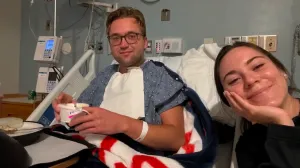
Tufts Medical Center stroke expert Lester Leung, MD, MSc, Director of the Stroke and Young Adults (SAYA) Program, shares what you need to know about stroke before age 50.
Did you know that 1 in 7 strokes happens in someone between the ages of 18 and 50? This is known as “young adult stroke.” Stroke can also affect babies, children and teens. In fact, it occurs in about 1 in every 4,000 live births.
Stroke is more often disabling than fatal. That means many people live with the long-term effects of a brain or spinal cord injury caused by stroke. It's estimated that 1 in 4 stroke survivors had their stroke before turning 50.
Knowing the risks and recognizing the signs early can help protect your brain health at any age.
First, what is a stroke?
A stroke happens when blood flow to the brain is interrupted—either by a blockage or a ruptured blood vessel. This cuts off oxygen and nutrients to brain cells, which can begin dying within minutes. There are 3 main types of stroke:
- Ischemic Stroke: The most common type, especially in people under 50. It occurs when a blood clot blocks an artery to the brain.
- Hemorrhagic Stroke: Caused by bleeding in or around the brain when a blood vessel ruptures.
- Transient Ischemic Attack (TIA): Often called a “mini-stroke,” this is a temporary blockage that serves as a warning sign of a future stroke.
What are the risk factors of stroke for young adults?
Risk factors for stroke are largely the same across age groups, but some are more common or go undetected in younger people.
- Common across all ages
- High blood pressure (hypertension)
- High cholesterol (hypercholesterolemia)
- High blood sugar (diabetes)
- Obesity and lack of exercise
- Smoking
- More relevant for young people (even those who are otherwise healthy)
- Birth control pills with estrogen
- Pregnancy and postpartum changes
- Migraines with aura
- Heart defects like a patent foramen ovale (hole in the heart)
- Sickle cell disease
- Substance use disorders (alcohol, cannabis, cocaine, amphetamines)
Strokes can look the same regardless of age. Call 911 immediately if you notice:
- Balance: A sudden loss of balance can be a sign of stroke.
- Eyes: Sudden vision changes, such as blurred vision or double vision, can also indicate a stroke.
- Face: A sudden droop or numbness on one side of the face is a key symptom.
- Arm: Sudden weakness or numbness in one arm, especially if it drifts down, can be a stroke sign.
- Speech: Difficulty speaking or slurred speech can also be a warning sign.
- Time: Time is critical. A stroke is a medical emergency and immediate action is needed to maximize recovery.
How is post-stroke care for young adults unique?
First, there are many more causes of stroke in young adults as compared to older adults. Because of this, the diagnostic process of identifying a young stroke survivor’s cause can be much longer and more intensive than for most older adults. Treatments for stroke prevention also may be continued for many more decades of life.
A second difference is that young stroke survivors live with the consequences of their stroke for many more decades. Disability from stroke may affect their ability to raise families, take care of their parents, drive motor vehicles and continue their work or professional development. Young stroke survivors tend to have more frequent late complications after stroke, such as depression, anxiety, seizures, chronic headaches, fatigue, sleep disorders, movement disorders and more. These late complications likely affect their recovery and worsen their quality of life after stroke. Many young stroke survivors struggle with their altered identity and the need to reconcile their new life trajectory after stroke with their prior goals and aspirations.
Our Stroke and Young Adults (SAYA) program is designed specifically for young stroke survivors. We specialize in providing coordinated, long-term care for young stroke survivors, helping prevent future strokes, identifying and managing ongoing symptoms and providing survivorship counseling and to help them navigate personal and professional challenges.
How can young people reduce their risk of stroke?
You can reduce your risk of stroke at any age by doing the following:
- Eat a balanced, heart-healthy diet
- Exercise regularly
- Limit alcohol intake
- Maintain a healthy weight
- Manage stress
- Manage your blood pressure, cholesterol and sugar
- Quit any tobacco or nicotine-containing products
The bottom line
Stroke can happen to anyone, at any age, at any time. But the choices you make today—how you eat, move, manage stress and care for your health—can significantly reduce your risk. Don’t wait until it’s too late. Stay informed, stay proactive and protect your brain health for the long run.

